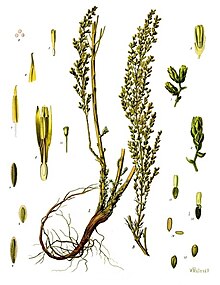| Artemisia | |
|---|---|

| |
| Artemisia cina (Levant wormseed)[1] | |
| Scientific classification | |
| Kingdom: | Plantae |
| Clade: | Tracheophytes |
| Clade: | Angiosperms |
| Clade: | Eudicots |
| Clade: | Asterids |
| Order: | Asterales |
| Family: | Asteraceae |
| Subfamily: | Asteroideae |
| Tribe: | Anthemideae |
| Genus: | Artemisia L. |
| Type species | |
| Artemisia vulgaris L.
| |
| Synonyms[2] | |
| |
Artemisia (/ˌɑːrtɪˈmiːziə/)[3] is a large, diverse genus of plants belonging to the daisy family, Asteraceae, with almost 500 species. Common names for various species in the genus include mugwort, wormwood, and sagebrush.
Some botanists split the genus into several genera, but DNA analysis[4] does not support the maintenance of the genera Crossostephium, Filifolium, Neopallasia, Seriphidium, and Sphaeromeria; three other segregate genera—Stilnolepis, Elachanthemum, and Kaschgaria—are maintained by this evidence. Occasionally, some of the species are called sages, causing confusion with the Salvia sages in the family Lamiaceae.
Artemisia comprises hardy herbaceous plants and shrubs, which are known for the powerful chemical constituents in their essential oils. Artemisia species grow in temperate climates of both hemispheres, usually in dry or semiarid habitats. Notable species include A. vulgaris (common mugwort), A. tridentata (big sagebrush), A. annua (sagewort), A. absinthium (wormwood), A. dracunculus (tarragon), and A. abrotanum (southernwood). The leaves of many species are covered with white hairs.
Most species have strong aromas and bitter tastes from terpenoids and sesquiterpene lactones, which discourage herbivory, and may have had a selective advantage.[5] The small flowers are wind-pollinated.[5] Artemisia species are used as food plants by the larvae of a number of Lepidoptera species.
- ^ 1897 illustration from Franz Eugen Köhler, Köhler's Medizinal-Pflanzen
- ^ a b "Artemisia vulgaris". Global Compositae Checklist.[permanent dead link]
- ^ Sunset Western Garden Book (6th ed.). Leisure Arts. 1995. pp. 606–607. ISBN 978-0-376-03851-7.
- ^ Watson LE, Bates PL, Evans TM, Unwin MM, Estes JR (September 2002). "Molecular phylogeny of Subtribe Artemisiinae (Asteraceae), including Artemisia and its allied and segregate genera". BMC Evolutionary Biology. 2: 17. doi:10.1186/1471-2148-2-17. PMC 130036. PMID 12350234.
- ^ a b Cite error: The named reference
fnawas invoked but never defined (see the help page).